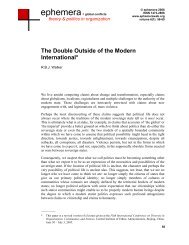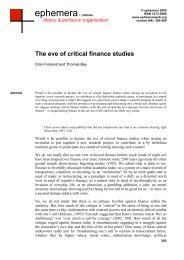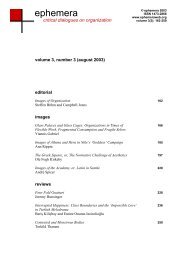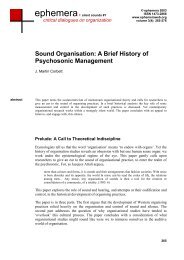Work, play and boredom - Ephemera
Work, play and boredom - Ephemera
Work, play and boredom - Ephemera
Create successful ePaper yourself
Turn your PDF publications into a flip-book with our unique Google optimized e-Paper software.
© 2011 ephemera 11(4): 387-405 In praise of <strong>boredom</strong><br />
articles Norman Jackson <strong>and</strong> Pippa Carter<br />
We would suggest that ‘engagement’ is, at best, no more than a reworking of this<br />
general approach, but without the rigorous theoretical basis of the original – a kind of<br />
‘ordinary language’ version of OD, recycled to fit into the very different conditions that<br />
pertain half a century later. One of the more surprising aspects of both the campaign <strong>and</strong><br />
the report on which the campaign rests is the relapse into the sentiments <strong>and</strong> practices of<br />
this OD movement, in an epoch where those at the top of the organizational pile seem to<br />
need, <strong>and</strong> indeed claim to need, unbelievably large cash bonuses to make them engage.<br />
Seemingly, those at the bottom still do not. The old adage remains true: To make the<br />
rich work harder you pay them more, to make the poor work harder you pay them less.<br />
In the ‘old days’ it felt ‘right’ for managers to beat more effort out of workers <strong>and</strong> there<br />
is some evidence that this is not altogether history (see, for example, Equality <strong>and</strong><br />
Human Rights Commission [2010] for such evidence in the UK, <strong>and</strong>, rather more<br />
bizarrely, Ehrenreich, 2009: 103, on what she calls ‘motivational spankings’). As<br />
workers slowly acquired more protection from employers, the modest bonus scheme<br />
became, (if piece-work was not viable), the preferred method to ‘incentivise’ – or, more<br />
correctly, ‘incite’ – workers. During this developing underst<strong>and</strong>ing of man(sic)management,<br />
it was still routinely part of the conceptualisation of the relations between<br />
employer <strong>and</strong> employed that there was an inherent conflict of interest between them,<br />
each party seeking to optimise their material benefits from the work-effort expended.<br />
The advent, in the 1940s <strong>and</strong> 1950s, typically attributed to Maslow, of the theory that<br />
psychological satisfaction could be gained through work spawned the heyday of the<br />
motivation-to-work theorists. Conveniently forgetting its clinical origins (see, for<br />
example, Maslow, 1943), this theory soon metamorphosed into a theory applicable to an<br />
abstracted concept of wage labour. Its use in practice in this form also conveniently<br />
omitted the requirement that higher level needs did not kick in until lower level ones<br />
were satisfied, a major manifestation of which was an adequate wage. And, as Vroom<br />
showed with Expectancy Theory (1964), (a final recognition of the subjectivity of<br />
motivation), adequacy of satisfaction of lower level needs is something determined by<br />
the worker, not by managers. The widespread perception that, however reasonable a<br />
theory Expectancy Theory might be, it is impossible to operationalise in the workplace,<br />
is, we have argued elsewhere (Carter <strong>and</strong> Jackson, 1993), largely attributable to this<br />
observation, that motivation to work, as opposed to behaviour, cannot be manipulated<br />
by managers, but is a perception of the desirability of the potential rewards offered, on<br />
the part of the worker.<br />
Inherent plurality of interest, <strong>and</strong> the role of perception in motivation, created a problem<br />
for encouraging the worker to greater effort. This problem was ‘solved’ with the advent<br />
of Human Resource Management by its (unilateral) declaration of the indivisibility of<br />
interest amongst those associated with ‘the organization’ – unitarism, then, usurped<br />
pluralism as the operant management ‘philosophy’. This allowed the development of<br />
the model of the rhetorically re-valorised worker – ‘our employees are our most<br />
valuable resource’ – alongside management techniques that engineered an increasingly<br />
infantilised employee (see, for example, Sievers, 1994), a condition necessary to<br />
dissuade the workers from questioning ‘management’s right to manage’. However, it<br />
would appear that reducing the workers’ autonomy has not encouraged their<br />
‘engagement’ with the organization. Hence the need for a government initiative.<br />
391








